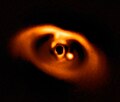Research
The main goal of the Carl Sagan Institute is to model atmospheric spectral signatures including biosignatures of known and hypothetical planets and moons to explore whether they could be habitable and how they could be detected. [4] Their research focuses on exoplanets and moons orbiting in the habitable zone around their host stars. The atmospheric characterization of such worlds would allow researchers to potentially detect the first habitable exoplanet. [4] A team member has already produced a "color catalog" that could help scientists look for signs of life on exoplanets. [5]
Bioreflectance spectra catalog
Team scientists used 137 different microorganism species, including extremophiles that were isolated from Earth's most extreme environments, and cataloged how each life form uniquely reflects sunlight in the visible and near-infrared to the short-wavelength infrared (0.35–2.5 μm) portions of the electromagnetic spectrum. [6] This database of individual 'reflection fingerprints' (spectrum) might be used by astronomers as potential biosignatures to find large colonies of microscopic life on distant exoplanets. [5] A combination of organisms would produce a mixed spectrum, also cataloged, of light bouncing off the planet. The method will also be applied to spot vegetation. [7] The goal of the catalog is to provide astronomers with a baseline comparison to help scientists interpret the data that will come back from telescopes like the Nancy Grace Roman Space Telescope and the European Extremely Large Telescope. [5]
Ultraviolet radiation on life forms could also induce biofluorescence in visible wavelengths. [8] [9] An exoplanet orbiting an M-type star with these life forms would glow when exposed to solar flares, allowing it to be detected by the new generations of space observatories.
Other catalogs and models
Institute scientists have catalogued the spectral emissions and albedo of Solar System objects, including all eight planets, nine moons, and two dwarf planets. [10] They have also modeled Earth's atmosphere throughout geological history. [11] Exoplanets with similar conditions to early Earth are considered candidates for emerging life forms.
This page is based on this
Wikipedia article Text is available under the
CC BY-SA 4.0 license; additional terms may apply.
Images, videos and audio are available under their respective licenses.
